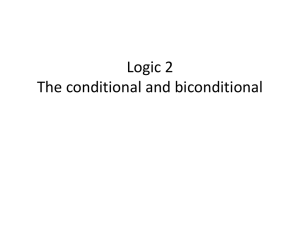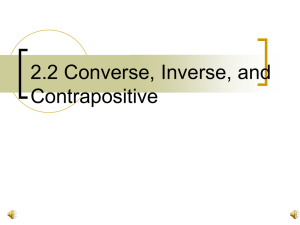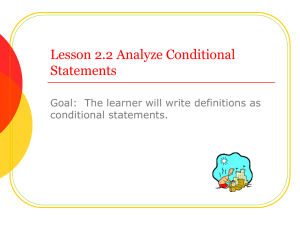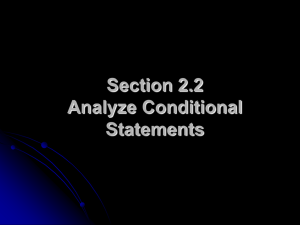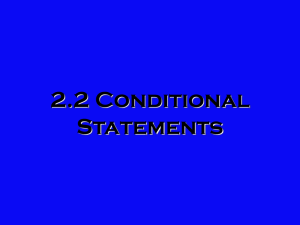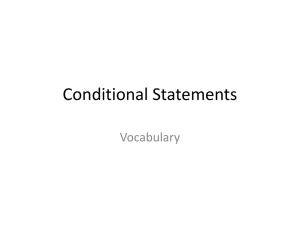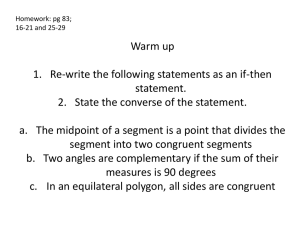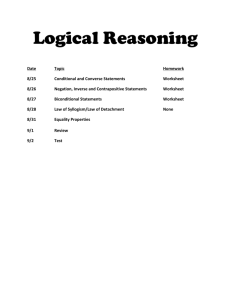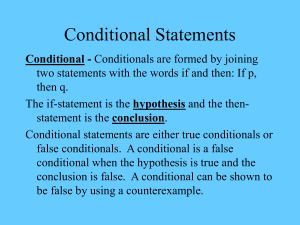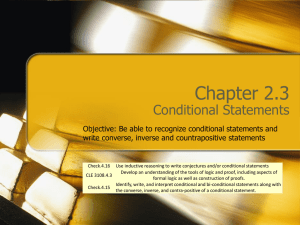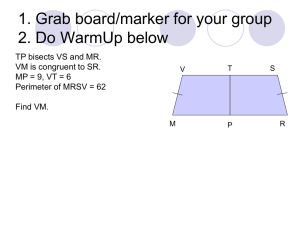conditional statement
advertisement
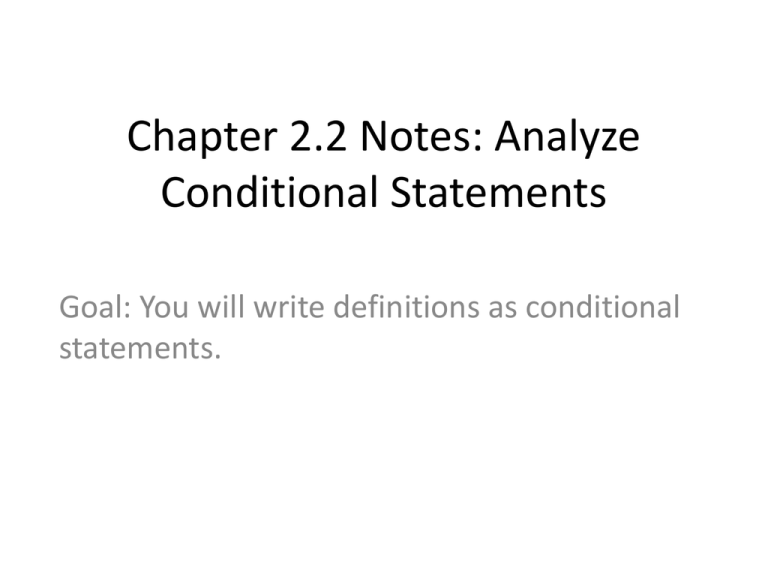
Chapter 2.2 Notes: Analyze Conditional Statements Goal: You will write definitions as conditional statements. • A conditional statement is a logical statement that has two parts, a hypothesis and a conclusion. • When a conditional statement is written in if-then form, the “if” part contains the hypothesis and the “then” part contains the conclusion. i.e. If it is raining, then there are clouds in the sky. Ex.1: Rewrite the conditional statement in if-then form. a. All birds have feathers. If an animal is a bird, then it has feathers. b. Two angles are supplementary if they are a linear pair. If two angles are supplementary angles, then they are a linear pair. OR If two angles form a linear pair, then they are supplementary angles. Ex.2: Rewrite the conditional statement in if-then form. a. All whales are mammals. If an animal is a whale, then it is a mammal. b. Three points are collinear if there is a line containing them. If three points are collinear, then there is a line containing them. OR If there is a line containing three points, then the three points are collinear. Ex.3: Rewrite the conditional statement in if-then form. a. All 90o angles are right angles. If an angle measures 90o, then it is a right angle. b. Tourists at the Alamo are in Texas. If tourists are at the Alamo, then they are in Texas. • Negation: • The negation of a statement is the opposite of the original statement. Ex.4: Statement 1: The ball is red. Negation 1: The ball is not red. Ex.5: Statement 2: The cat is not black. Negation 2: The cat is black. • Verifying Statements: • Conditional statements can be true or false. • To show that a conditional statement is true, you must prove that the conclusion is true every time the hypothesis is true. • To show that a conditional statement is false, you need to give only one counterexample. • Related Conditionals: o If mA 99 , then A is obtuse. • To write the converse of a conditional statement, exchange the hypothesis and conclusion. Converse: If angle A is obtuse, then the measure of angle A is 99o. • To write the inverse of a conditional statement, negate both the hypothesis and the conclusion. Inverse: If the measure of angle A is not 99o, then angle A is not obtuse. • To write the contrapositive, first write the converse and then negate both the hypothesis and the conclusion. Contrapositive: If angle A is not obtuse, then the measure of angle A is not 99o. Ex.6: Write the conditional statement in if-then form, the converse, the inverse, and the contrapositive of the statement “Soccer players are athletes.” Decide whether each statement is true or false. Conditional: If a person is a soccer player, then they are an athlete. Converse: If a person is an athlete, then they are a soccer player. Inverse: If a person is not a soccer player, then they are not an athlete. Contrapositive: If a person is not an athlete, then they are not a soccer player. Ex.7: Write the if-then form, the converse, the inverse, and the contrapositive of the conditional statement “Guitar players are musicians.” Decide whether each statement is true or false. Conditional: If a person is a guitar player, then they are a musician. Converse: If a person is a musician, then they are a guitar player. Inverse: If a person is not a guitar player, then they are not a musician. Contrapositive: If a person is not a musician, then they are not a guitar player. Ex.8: Write the converse, the inverse, and the contrapositive of the conditional statement, “If a polygon is equilateral, then the polygon is regular.” Converse: If a polygon is regular, then the polygon is equilateral. Inverse: If a polygon is not equilateral, then the polygon is not regular. Contrapositive: If a polygon is not regular, then the polygon is not equilateral. • Equivalent Statements: • A conditional statement and its contrapositive are either both true or both false. • Similarly, the converse and inverse of a conditional statement are either both true or both false. • When two statements are both true or both false, they are called equivalent statements. • Definitions: • You can write a definition as a conditional statement in if-then form or as its converse. • Both the conditional statement and its converse are true. • Perpendicular Lines: • If two lines intersect to form a right angle, then they are perpendicular lines. • The definition can also be written using the converse: If two lines are perpendicular lines, then they intersect to form a right angle. • You can write “line l is perpendicular to line m” as __________________. • Biconditional Statements: • When a conditional statement and its converse are both true, you can write them as a single biconditional statement. • A biconditional statement is a statement that contains the phrase “if and only if.” – Any valid definition can be written as a biconditional statement. Ex.9: Write the definition of perpendicular lines as a biconditional. Definition: If two lines are perpendicular lines, then they intersect to form a right angle. Converse: If two lines intersect to form a right angle, then they are perpendicular lines. Biconditional: Two lines are perpendicular lines if and only if they intersect to form a right angle. Ex.10: Write the definition of supplementary angles as a biconditional. Definition: If two angles are supplementary angles, then their measure is 180o. Converse: If the measure of two angles is 180o, then they are supplementary angles. Biconditional: Two angles are supplementary angles if and only if their measure is 180o. Ex.11: Use the diagram shown. Decide whether each statement is true. Explain your answer using the definitions you have learned. a. JMF and FMG are supplementary. b. Point M is the midpoint of FH . c. JMF and HMG are vertical angles. d. FH JG
